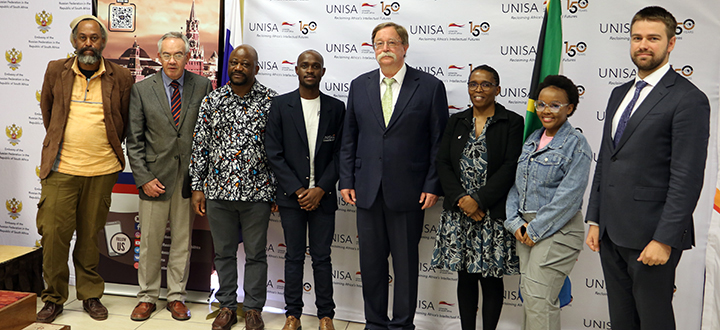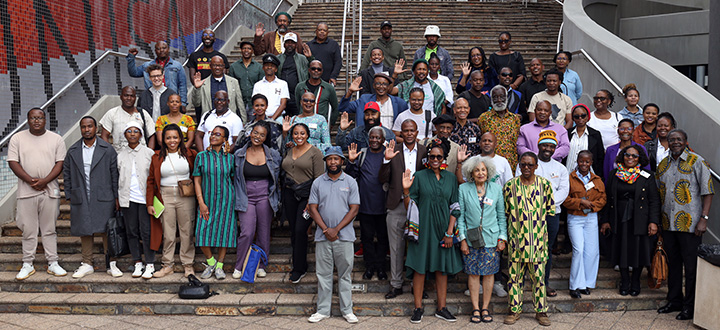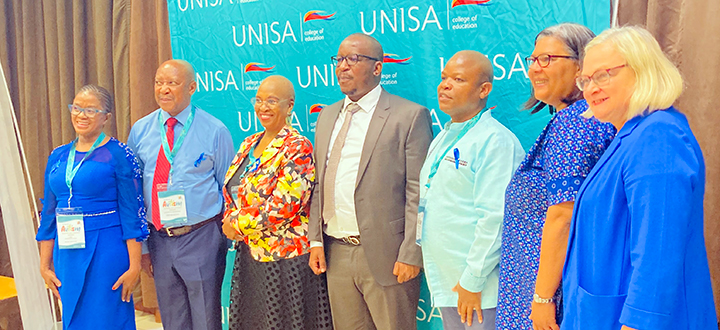College of Agriculture & Environmental Sciences
Science-based opportunities for smallholder livestock farmers in Africa
The Department of Agriculture and Animal Health of the College of Agriculture and Environment Sciences (CAES) hosted an African Scholar Lecture on 24 August 2021, under the theme “Science-based opportunities for smallholder livestock farmers in Africa”.

Professor Appolinaire Djikeng
CAES extended a warm welcome to Professor Appolinaire Djikeng, who was the visiting African scholar for the day. Prof Djikeng is an Academic Associate in the Department of Agriculture and Animal Health. He is a leading Genomics scientist with over 20 years’ experience in research and development with a focus on creating solutions to tackle agricultural development and global health challenges. His current research, capacity building and international development interests are cantered on livestock genetic improvement targeting smallholder farmers in low- and middle-income countries (LMICs) and human health.
In his presentation, Prof Djikeng stated that our food systems have become vulnerable, so we must centre our focus on how to build, strengthen or have resilient food systems that will continue to function as we find ways to manage the following crises:
- decline of natural resources, particularly water
- collapse of ecosystems and loss of biodiversity
- global warming and human-induced climate change
- chemical pollution of the Earth system, including the atmosphere and oceans
- rising food insecurity and failing nutritional quality
- pandemics of new and untreatable diseases
- the advent of new powerful and uncontrolled technologies
How can we prevent and manage all these risks? Prof Djikeng thinks that the above list is not exhausted, but he managed to identify some of these traits to centre the discussion amongst the academics. “We should be seeing ourselves as key contributors developing to the solutions and participating in building evidence for us to tackle some of these crises. Some of these crises essentially are here at moment and very profound because either we did not apply the correct solution when needed to or when the solution was developed, we really did not push for policies based on the evidence.” Prof Djikeng emphasises the fact that solutions should represent the right framework for us to be thinking about our work, teaching, research conducted and community engagement that academic institutions have to have.
Prof Djikeng recalled the first time that South Africa went on a lockdown due to the coronavirus with strict regulations (people could not go to work), and most people were worried about food supplies.
On top of that, even in normal circumstances we have the greatest challenge that we must meet – producing enough food. We often ask ourselves: How we can achieve that without destroying the environment?
For those who are familiar with the food system, you see that across the world everything we produce does not just end up on the plate; so part of what we should put the focus on is really to reduce food waste, either through the value chains that are broken, or through logistics and our consumer pattern as people.
The State of Food Security and Nutrition in the World in 2021, conducted by UNICEF, FAO, IFAD, WFP and WHO, states that for the past two to three decades, these agencies have been on an annual basis examining the state of food security and nutrition across the world. According to their findings, moderate to severe food insecurity is still increasing globally despite all the investments and technologies. In Africa during 2019 to 2021, there has been a significant increase in people who are facing severe food insecurity. Prof Djikeng's call to this challenge is that we should think about creating solutions to reverse this threat, otherwise we are really heading towards a significant crisis.
Looking at the study conducted by above agencies, you can tell that one out of four Africans is actually facing severe food insecurity. This is not because those 25% of us have done something wrong, but it is just that they found themselves in this situation; therefore, it is our duty to drive Africa out of this situation. You can see that compared to other parts of the world, we are worse off; it is a call for as to actually take this as a priority with developed home-ground solutions to tackle this issue. To make it even worse, we see that if you combine people who are facing severe and moderate food insecurity, we are looking at 60% of us in Africa. “How can we talk about sustained economic development if 60% of us are so vulnerable? We must find a solution. People must start asking themselves questions like: Where are we heading to since this crisis is not new? We should implement the sustainable development goals that many countries, whether in the global south or north, have subscribed to,” said Prof Djikeng.
These goals represent a good framework for us to create a scorecard on how our intervention from teaching, building capacity and research can help drive this. From his perspective, Prof Djikeng would like to see the sustainable development growth in the livestock development, which is a good part of agricultural development. He would like to convince the audience that sustainable development goals can be achieved with a significant contribution from livestock development, and this has been his working assumption for the past several years. "Bring this home to Africa; I just want to highlight what Prof Lebelo mentioned that in the Africa Union Agenda 2063, one of the goals in that powerful document is to have modern agriculture for increased productivity and production," said Prof Djikeng. He also mentioned the African Development Bank, which has developed the livestock development master plan. The Bank aligned it with the sustainable development goals, again reinforcing the notion that we can have a good framework for us to drive intervention that will help Africa to contribute not only to the global community but to drive us to significantly reduce the proportion of us facing moderate or severe food insecurity.
Four pillars of strategy for sustainable and inclusive transformation of Africa's livestock sector
Livestock play a major role in sustainable food systems – for example, manure is a critical source of natural fertiliser, while livestock used as draft animals can help boost productivity in regions where there is low mechanisation. Livestock are important assets for vulnerable communities.
Pillar 1: Sustainably raising livestock productivity
The aim of the first pillar is to increase livestock productivity through targeted genetic improvement, animal health and better feeds by improving access to supplies, services and knowledge. This will include fostering sustainability and resilience at the same time with respect to the climate readiness of livestock systems, improved biodiversity and agroecological system. Improving the productivity of livestock systems requires improvements in the genetics, feeding and health care of animals. The genetic potential of many livestock breeds is low, but they are often well adapted to the local environment. However, improved and adapted genotypes can be introduced through targeted crossbreeding and using new genetic tools, such as within-breed genomic selection coupled with digital tools to collect phenotypic information directly from smallholder farmers. Animal feeding is very often a critical limiting factor to better productivity. Climate-smart and gender-responsive interventions to improve animal nutrition can make a significant difference to productivity.
These include improving specific fodder crops; upgrading the nutritive value of crop residues; better use of by-products such as cassava peels; feed processing; and pasture management. Access to effective veterinary products and services to improve animal health and so reduce animal mortality and losses in productivity are also important to raise productivity. The delivery of products and services to livestock producers, backed by surveillance systems and diagnostic capacity will also be supported. Many diseases are transboundary and will require cross-border or regional cooperation to ensure they are better controlled. Insurance for livestock assets against health and climatic risks, through methods like index-based insurance and strengthened early warning systems can help de-risk investments for small farmers.
Pillar 2: Improved marketing and value chain development including enhancing
Value addition through processing the second pillar will focus on market and value chain development. This will include: commercialisation of livestock production and animal products; developing market infrastructure; introducing digital innovations and platforms; linking smallholder farmers to markets; improving processing and value addition of animal products; and cold chain development. Targeted opportunities for supplying local, regional and international markets will also be identified. The Bank’s analysis showed that even the most complex livestock commodities still use low technology solutions for their processing, that is, no medium or high-technology processes are required to produce livestock commodities. Despite this, most African countries do not have the capabilities to transform raw materials into manufactured products. Instead, they import ready-processed products. These are mostly dairy (milk and cream), products which account for 25% of total livestock commodity imports, and prepared and edible products (22%), although the picture varies by region and country. These commodities are largely processed with considerable value addition, while the most exported products are live animals (14%) and unfinished leather and hides or skins (27%), largely without any value addition.
Pillar 3: Promoting sustainable food security and nutrition through animal source foods
Recognising that the increasing intensification of the livestock sector could potentially also carry risks to both animal and human health through food safety, zoonotic diseases and antimicrobial resistance, the third pillar will adopt a holistic “One Health” approach to these challenges, bringing together animal, human and environmental health. Globally, Africa is the region most affected by undernutrition. A total of 19.1% of its population is undernourished and 256 million people go hungry11. The extent of the undernutrition gap makes the goal of eliminating hunger by 2030 doubtful. Despite countries’ serious efforts to address malnutrition, it continues to rise, and the progress is too slow to meet the World Health Assembly’s nutrition targets. About 30% of children under five years of age are stunted, meaning they have impaired growth and development through undernutrition, which will inhibit their ability to reach their potential throughout their lives. In addition, 38.1% of the women of reproductive age are anaemic, risking both their health and that of their future infants, and 17% of women are obese. Africa is the region most affected by overlapping forms of malnutrition. Indeed, 27 of the 37 countries affected by three forms of malnutrition – childhood stunting, overweight in women and anaemia in women of reproductive age – are in Africa.
Pillar 4: One Health
Given the critical importance of animal source foods in human nutrition and health, the fourth pillar will focus on promoting sustainable, safe and healthy diets, food security and nutrition through animal source foods, ensuring that investments are nutrition sensitive. This pillar will also promote consumer awareness among the population sectors that would most benefit from consuming more animal-sourced foods.
It has been clear to many for some time that the health of animals, humans and the environment are inextricably connected. The COVID-19 pandemic has brought this connection sharply into focus and brought it to the attention of decision makers at the highest levels of governments. A “One Health” approach to dealing with these interconnected issues has developed over the past 20 years. There are many definitions of One Health and the related field of eco health: common to all is the idea that human health is dependent on the health of the environment and animals, both wild and domesticated. From a livestock sector perspective, the area’s most conducive to a One Health approach are zoonotic diseases (emerging zoonoses with pandemic potential and endemic zoonoses), food safety and antimicrobial resistance.
Options for the livestock sector in developing and emerging economies to 2030 and beyond
Firstly, transform small‑ and medium‑scale mixed crop‑livestock and livestock-herding production systems into sustainable and profitable enterprises. This first option presents significant opportunities for emerging and developing countries by raising productivity while enhancing the livestock-dependent livelihoods of several hundred million people. Governments have opportunities to ensure their rapidly growing livestock sectors fulfil their potential to accelerate and sustain national economic growth. Grasping such opportunities will also require alternative livelihood options for those unsuccessful at transforming their enterprises. In addition, as productivity responds to market demand, appropriate measures must help to avoid unintended health or environmental consequences.
Secondly, develop industrial‑scale livestock production enterprises. Industrial‑scale production systems for raising livestock, common in high‑income countries, are increasing in emerging and developing economies. Such systems can produce livestock‑derived foods with a lower environmental footprint per unit of product than other systems, can enhance farmers’ access to inputs and services, and can make livestock‑derived foods more readily available and accessible to all consumers. But adoption of such concentrated operations presents big challenges. The livestock production systems of high-income economies typically confine large numbers of animals in “concentrated animal feeding operations”.64 Often referred to as “industrial” systems, they are sharply distinguished from the ubiquitous small-scale livestock systems of low- and middle-income economies. Animals raised on industrial farms are kept in large numbers and are fed high-quality cereal grains and plant-based proteins, especially soybeans, or fishmeal derived from capture fisheries.
Thirdly, import more livestock‑derived foods. Developing and emerging nations may choose to increase their imports of livestock‑derived foods produced by industrial systems in developed countries. While increased imports could improve access to the meat, dairy or eggs many consumers increasingly demand, they could also reduce local job opportunities and increase threats to the environment, public health and animal welfare. Imports of livestock-derived foods are usually in processed forms that increase their shelf life.71 Some of these products, especially those needing refrigeration, are found in urban supermarkets, restaurants and fast-food outlets. Some are relatively expensive, serving niche demand among urban elites.
Other imports are accessible to poorer consumers; these include powdered or condensed milk, tinned meat and low-value cuts of meat, such as turkey tails and chicken backs and feet, which are scarcely demanded in more developed economies.72 Small packets of these
lower-value livestock-derived foods may give some consumers their first regular access to them. Small sachets of milk powder, for example, are sold for the equivalent of a few cents each in West Africa, where fresh milk is in short supply and too expensive for poor populations. Both the volume and the proportion of imported livestock-derived foods have increased significantly in many developing and emerging economies.
The fourth option is to have alternative forms of protein. Mostly high‑income economies are exploring alternative forms of protein (alt‑proteins). These innovations will undoubtedly generate spill-over benefits for emerging, developing and developed economies and are likely to contribute to solving the world’s protein needs. Their potential to provide sustainable, economically viable solutions to help meet the nutritional challenges facing developing countries needs to be explored further if they are to become meaningful options. Efforts should consider co‑designing solutions that leverage technologies developed in high‑income economies and jointly adapting those with high potential for emerging and developing nations.
Alt-proteins can include plant- or algae-based rather than animal-derived foods, as well as insects and alternative foods that mimic the look, feel and taste of meat, milk and eggs.
Improving tropical livestock development
The African, Caribbean and Pacific (ACP) region is endowed with a diversity of indigenous livestock genetic resources. Traditional breeding and selection tools were employed in the past to enhance their productivity. However, The ACP region is witnessing genetic erosion which can be linked to the limited human and technological capacity and enabling policies to manage genetic resources. Advances in biotechnology (genomics) can be used to map genetic stock to identify unique traits for improving livestock robustness and productivity. South Africa is engaged in collaborative research work to map the genes of indigenous breeds. Recent advances in endocrinology and in vitro fertilisation techniques make it possible to increase the reproductive rates of animals through synchronisation and artificial insemination. In the Caribbean, Cuba is a leader in the development and use of these technologies. Cloning is also an emerging issue in livestock breeding, and evidence-based strategies for safeguarding indigenous genetic resources should be explored by ACP countries.
Nutrition and feeding
Fluctuations in feed quality and quantity compromise nutritional quality. The main limiting nutrient in animal feeds is protein, and recent developments in optimising the use of legumes, shrubs and trees for feedstock and propagating them in all agroecological zones ranging from arid to wet areas would alleviate this constraint. The scarcity and poor quality of forages used as energy sources in the dry seasons is an additional constraint.
In conclusion, Prof Appolinaire Djikeng said: “As academics, we should be aware of the traits that we face globally but be concerned about generating the solutions that can help us to address the evidence that we pass on to policy makers, to help made the right decision.”
Publish date: 2021-09-13 00:00:00.0

 Unisa's student leadership engage with Russian ambassador
Unisa's student leadership engage with Russian ambassador
 Re-igniting and re-imagining Pan Africanism, Afrocentricity and Afrofuturism in the 21st century
Re-igniting and re-imagining Pan Africanism, Afrocentricity and Afrofuturism in the 21st century
 Young Unisa science stars join elite Lindau Nobel Laureate group
Young Unisa science stars join elite Lindau Nobel Laureate group
 Education MEC addresses Unisa autism seminar
Education MEC addresses Unisa autism seminar
 Seven Unisans nominated for the NSTF-South32 Awards 2023/2024
Seven Unisans nominated for the NSTF-South32 Awards 2023/2024